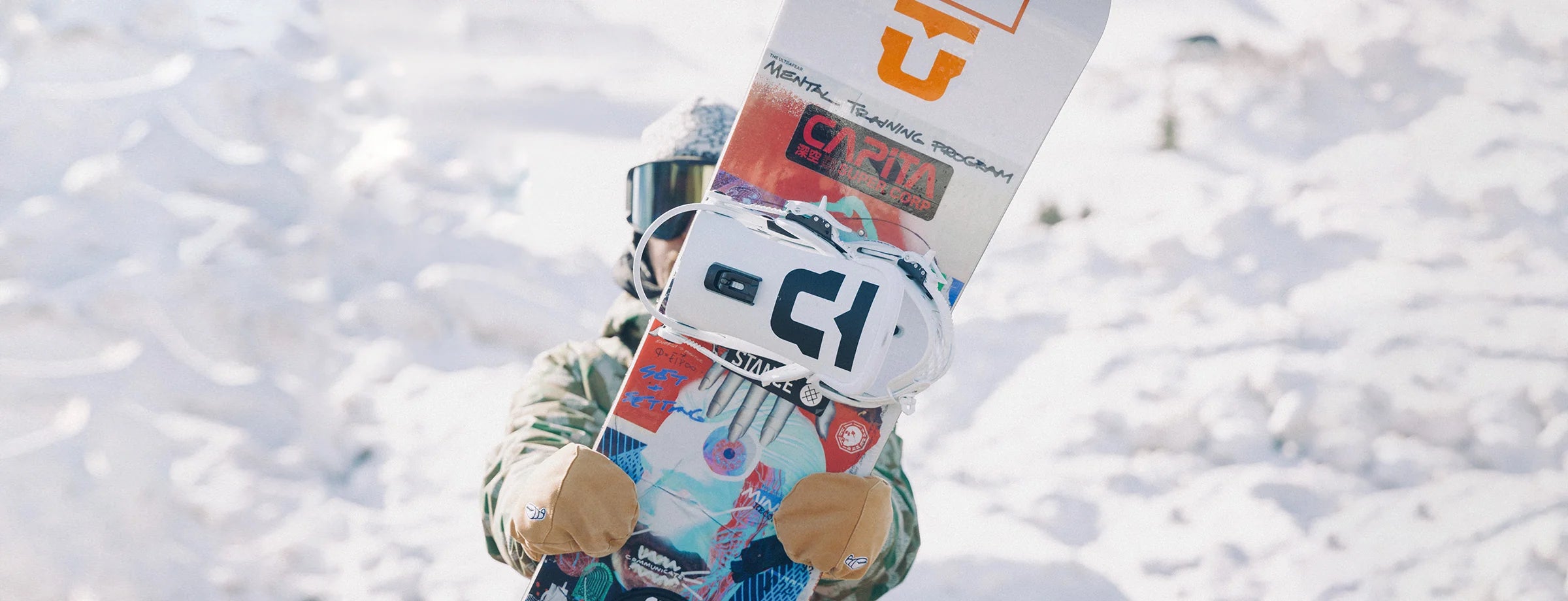When a rider asks, “What size snowboard should I ride?”, I always smile, because the answer isn’t just one number, it’s a range, guided by your height, weight, boot size, riding style, and the specific board brand.
At Switch, we help many riders dial in their perfect fit, and I want to share that know‑how with you.
In this guide, you’ll get:
- A clear sizing formula and charts
- How boot size affects width
- Adjustments for riding styles (freestyle, freeride, all‑mountain)
- Brand‑specific sizing tips (top 5 brands we carry)
- Real examples and a quick “cheat sheet”
Let’s dive in.
Check out our latest line of snowboards.
Switch Skate & Snow:
161 HARWOOD AVE N UNIT #6, AJAX, ONTARIO, L1Z0A1
Why Sizing a Snowboard Properly Matters
Making the wrong choice of snowboard size is equivalent to wearing size-two-too-big shoes; you will stumble, lose traction, or retard your learning process. A board that’s too large will be unpredictable in maneuverability, especially while performing tight turns or parking; one that’s too short will be loose at speed or at deep snow.
A well‑sized board enables you to carve pure, float over pow, spin in terrain park, and never feel out of place on groomers. It's an extension of you.
The Essential Factors: Height, Weight, Boot Size, Riding Style
1. Height & Weight — the starting point
A common rule (endorsed by many brands) is:
Your board should land somewhere between chest and chin level when standing upright next to you.
But that’s just a rough guide. Modern boards are shaped, volumized, and offer different flex, so weight often becomes a more precise tool. Brands like Never Summer emphasize using height, weight, boot size, and riding style as the baseline for your size decision.
For example, Never Summer publishes a size chart linking rider height/weight to board length (in cm).
Another sizing method:
- Board Length (cm) ≈ rider height (cm) × 0.88
Snowboard Sizing Chart:
| Rider Height | Rider Weight (lbs) | Recommended Snowboard Size (cm) |
|---|---|---|
| 4 ft 10 in | 110 – 120 | 128 – 136 |
| 5 ft | 115 – 130 | 133 – 141 |
| 5 ft 2 in | 125 – 135 | 139 – 147 |
| 5 ft 4 in | 135 – 145 | 144 – 152 |
| 5 ft 6 in | 140 – 155 | 149 – 157 |
| 5 ft 8 in | 150 – 165 | 154 – 162 |
| 5 ft 10 in | 160 – 175 | 159 – 167 |
| 6 ft | 170 – 185 | 160+ |
| 6 ft 2 in | 180 – 195 | 160+ |
| 6 ft 4 in | 190 – 205 | 160+ |
2. Boot Size → Board Width
Your boot size determines how wide your board’s waist (narrowest midsection) should be. If your board is too narrow, your boots will overhang excessively (risking drag); too wide, and you’ll feel sloppy edge transitions.
If your boots are US 11+, you should strongly consider wide or mid‑wide boards.
A practical check: with bindings on, your toe and heel overhang should be just slight and not hit the snow at full edge.
3. Riding Style Adjustment
Once height, weight, and boot width suggest a range, shift based on how and where you ride:
- Freestyle / Park / Jibbing → go toward the shorter end of that range. You’ll get easier spins, quicker pivots, and a more playful feel.
- All‑Mountain / Versatile Riding → aim for the center of the range. Balanced between agility and stability.
- Freeride / Powder / Big Mountain → lean toward the longer end. Extra length gives more float, stability at speed, and better control in variable conditions.
Many brands explicitly advise beginners to choose a shorter board in their range for easier control, and advanced riders can size upward for stability.
Top 5 Brands We Carry
Below are five brands you’ll often find on our racks at Switch Skate & Snow. These are not random; they’re among the best in quality and design.
CAPiTA Snowboards:
CAPiTA boards are known for their versatility and bold design. Whether you're charging all-mountain lines or lapping the park, CAPiTA has you covered. Their sizing tends to follow a balanced flex and true-to-length profile—meaning the length you choose rides close to its measurement, without dramatic volume shifts.
Sizing Tips:
-
True-to-size fit across most models
-
For freestyle, you can size down 2–4 cm comfortably
-
For freeride/powder boards like the Spring Break, go with the chart recommendation or slightly longer
-
Boot sizes US 11+ should opt for mid-wide or wide options when available
Best For: Riders who want pop, stability, and a smooth transition between park and all-mountain.
2. NIDECKER
NIDECKER blends European engineering with rider-friendly shaping. Their boards often use directional camber and rockered tips, allowing riders to size down slightly without losing edge control or float.
Sizing Tips:
-
Most models support volume-shift sizing, meaning you can drop 3–5 cm compared to traditional boards
-
Great for intermediate to advanced riders who want more control in a slightly shorter ride
-
NIDECKER includes waist width specs clearly—always match with your boot size
-
Lighter riders may find the flex forgiving in mid-lengths
Best For: All-mountain and freeride riders looking for innovation and smooth turns.
3. BATALEON
BATALEON is known for its Triple Base Technology (3BT), which lifts the edges slightly near the tip and tail for a catch-free, surfy feel. This tech impacts sizing—boards feel more forgiving and maneuverable, so many riders can comfortably ride a shorter size.
Sizing Tips:
-
Consider sizing down 2–3 cm from traditional lengths due to 3BT
-
Ideal for park riders and freestyle enthusiasts
-
Despite the shorter length, boards feel stable at speed due to tech-enhanced design
-
Check width charts carefully—some boards lean slightly narrow
Best For: Jibbers, jumpers, and anyone who loves buttery turns without losing control.
4. PUBLIC
PUBLIC Snowboards, with their youth-driven, park-oriented DNA, have a loyal following for a reason. These boards are built playful but still pack solid pop and edge grip. Their sizing is straightforward and traditional—no wild shape experiments here.
Sizing Tips:
-
Choose a size within your standard height/weight range
-
For park-only riders, going 2–4 cm shorter works great
-
PUBLIC boards have a classic camber feel—ride them like you would a traditional deck
-
Ideal width for US Men’s boots sizes 8–11; wide options limited
Best For: Street riders, urban features, park laps, and creative lines.
5. RIDE
RIDE Snowboards bring a blend of tech and toughness. Their models like the Warpig have become known for volume-shifted sizing—shorter boards with wider waists and more surface area, letting you downsize without giving up performance.
Sizing Tips:
-
Use their volume shift chart when selecting models like Warpig or Psychocandy
-
Go 6–10 cm shorter than your all-mountain board on some volume-shifted models
-
Traditional camber boards (e.g., Algorythm) ride true-to-size
-
Check waist width closely if you’re in the US 10.5+ boot range
Best For: Riders who want fun shapes with modern tech and unmatched board feel.
Putting It All Together: A Step‑by‑Step Fit Guide
Here’s a checklist you can follow (with a little math + reasoning) to answer “what size snowboard do I need?” step by step.
- Measure your height (cm) and weight (kg or lbs).
- Consult a general chart — e.g. a brand chart to get base range. (Switch suggests board length ≈ height × 0.88 as a guide.)
- Check boot size vs waist width from the brand’s spec.
- Decide riding style (park / all‑mountain / freeride) and shift within that range.
- Compare your choice against that brand’s chart — pick the size whose width and length both align.
- Demo or test (if possible) — nothing replaces feeling it on snow.
Common Mistakes to Avoid
-
Ignoring boot width. Too many riders choose a board by length but buy one with a narrow waist, then suffer toe drag.
-
Sticking to one rule. The “board to chin” trick is outdated with modern board design.
-
Over‑sizing for looks. Just because a board looks strong doesn’t mean you should stretch beyond your range.
-
Ignoring brand differences. A 156 cm Lib Tech may ride differently than a 156 cm Never Summer; charts aren’t fully interchangeable.
-
Not adjusting for weight extremes. Very lightweight or heavy riders need to be careful in charts — flex and volume matter more at extremes.
Real‑Life Example
Picture this: You’re 5′10″ (178 cm), weigh 170 lbs (77 kg), wear US Men’s 10 boots, and you ride mostly all‑mountain with occasional park.
- Base range (from charts) might suggest 150–158 cm.
- Boot width: check boards with waist width ~250–255 mm (for US 10) or mid‑wide if available.
- Since your style is “balanced,” you probably choose a board in the middle — maybe 155 or 156.
- If you lean into freeride, 157–158 is okay; into more park tricks, 153–154 might work.
Brand & Tips
| Brand | Recommended Sizing Strategy |
|---|---|
| CAPiTA | Stick to your traditional size range. Size down 2–4 cm for park. Ensure waist width matches boot size, especially with larger boots. |
| NIDECKER | Consider sizing down 3–5 cm due to volume-shift designs. Check waist width carefully. Ideal for riders seeking shorter, maneuverable boards. |
| BATALEON | Boards feel more forgiving thanks to Triple Base Technology. Size down 2–3 cm from standard lengths. Watch for narrower widths. |
| PUBLIC | True-to-size fit. Ideal for park riders who want classic camber feel. Size down 2–4 cm for freestyle performance. |
| RIDE | For volume-shifted boards like Warpig, size down 6–10 cm. Traditional models like Algorythm ride true-to-size. Check waist width if boots are US 10.5+. |
| SALOMON | Standard sizing works for most. Drop 2–3 cm for park-oriented boards. Hybrid camber allows slight size flexibility. Great wide options available. |
Conclusion
So, when someone asks “what size snowboard should I ride?”, the real answer is a range determined by your height, weight, boot size, and riding style, refined by the brand you choose. Starting from general charts online, checking boot width, and adjusting for how you ride will land you in that sweet spot.
If you’re shopping in the GTA or Durham Region, swing by our shop in Ajax, Switch can measure, compare brand charts right there, and help you try demo boards. Getting the right size at the start can save you months of frustration..
Ride confident, ride tuned.


